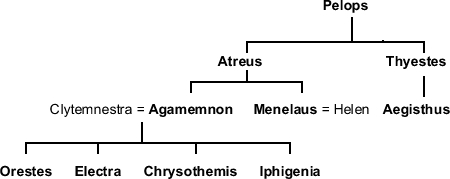
Persuasion in Ancient Greece
Andrew Scholtz, Instructor
Study Guides. . .
Oresteia, AgamemnonAeschylus' Oresteia trilogy
Click here for map of localities that figure in the trilogy.Readings Journal Entries
Based on the red-carpet scene, with the Agamemnon-Clytaemnestra agon (debate-like dialogue).
- Assume the persona of either. . .
- A "don't tread!" anti-Clytmnestra citizen of Argos
- A "do tread!" pro-Clytmnestra citizen of Argos
- In the persona of that person, talk to Agamemnon advisers. . .
- Convince them that Clytemnestra is right/wrong
Record this in your Reader-Response Journal. In class, we're going to stage a debate:
- Board of advisers to Agamemnon, easily swayed one way or the other
- Team "Do Tread"
- Team "Don't Tread"
Oresteia Trilogy
Production Facts
- Author: Aeschylus, Athenian tragic playwright (525/4-456 BCE)
- Three tragedies plus a lost satyr drama (Menelaus)
- Produced: Athens, 458 BCE
- Setting
- Agamemnon, Libation Bearers in Argos
- Eumenides at Delphi, then at Athens
- Time: aftermath of the Trojan War
- Story
- Agamemnon
- Agamemnon's return from Troy
- his and Cassandra's murder by Clytemnestra
- Libation Bearers
- Orestes and Electra (children of Agamemnon and Clytemnestra) kill
- Clytemnestra
- Aegisthus (Cl's lover) in revenge
- Orestes and Electra (children of Agamemnon and Clytemnestra) kill
- Eumenides
- Orestes is put on trial at Athens for the murder of his mother
- Agamemnon
Larger Questions
- What connections between dike (justice), kratos (power), peitho (persuasion) in Aeschylus' Oresteia?
- What role does peitho play in both the smaller and the larger movements of the trilogy?
- How does peitho affect events in the three plays?
- Does the action on stage bear any relation to events in mid fifth-century BCE Athens? Does the Oresteia say anything about peitho in the Athenian polis?
The Agamemnon
Difficulties
This is a very difficult play. You will need to read it carefully and slowly. Pay special attention to the choruses: most of the play is choral reflection - a bit like the playwright (Aeschylus) thinking out loud.
HOWEVER: the chorus has a habit of switching topic without warning. That is because the main mythological events (both plot and "prequel") addressed by the play . . .
- the "Feast of Thyestes"
- the Abduction of Helen
- the sacrifice of Iphigenia
- the Sack of Troy and Return of Agamemnon
. . . are, as it were, layered one on top of the other to bring out their parallelisms. Imagery, too (fire signals, carpet scene, etc.), is likewise laid out in parallel.
Plot
Since this is a more-than-usually difficult text, here's the story (quite simple, really):
- Fire signals bring news that Troy has been captured and destroyed, and that king Agamemnon will be returning soon to Argos
- Agamemnon arrives
- He is greeted by the chorus and by his wife, queen Clytemnestra
- He brings with him as a prize of war Cassandra, princess of Troy and prophetess
- Clytemnestra induces Agamemnon to tread on the red carpet
- Clytemnestra stabs Agamemnon in his bath
- Cassandra enters palace knowing full well that Clytemnestra intends to kill her (which Clytemnestra does)
- Clytemnestra and her lover, Aegisthus, savor their victory
Larger Themes
Keep a log of references or allusions to the following themes and concerns:
- dike ("justice")
- kratos ("power")
- Who exercises kratos (power) in the Agamemnon? How?
- peitho/bia
- What forms
- What means?
- What ends?
- By whom?
- What efficacy?
- What ethical resonances?
- peitho-bia interrelationship . . .
- antithetical?
- complementary?
Special Lecture/Discussion Topics
Peitho/peitho and . . .
- "Mystery passage" . . .
- "Persuasion the persistent overwhelms him, | she, strong daughter of designing ruin" (Chorus, lines 385-386)
- Who and what does the chorus refer to?
- What is the larger meaning of the passage?
- "Persuasion the persistent overwhelms him, | she, strong daughter of designing ruin" (Chorus, lines 385-386)
- Clytemnestra and gender issues
- feminine/masculine qualities
- Clytemnestra's
- peitho
- bia
Red-Carpet Scene
- Why does Clytemnestra want/need Agamemnon to tread on red carpet?
- How does she get him to?
Cassandra Scene (Chicago edition lines 1055-1342)
Cassandra possesses the power to read the future . . .
- Do people believe her?
Oresteia: Mythological Background
Genealogy: Pelops and his Descendants

"Prequel" Events
"Feast of Thyestes"
- The brothers Atreus and Thyestes, sons of Pelops, quarrel over the kingship at Argos
- Atreus seizes kingship; banishes Thyestes
- Atreus pretends reconciliation with Thyestes; invites him back to Argos
- At banquet, Atreus serves to Thyestes latter's own children (though not Aegisthus)
The Next Generation
- Atreus has two sons
- Menelaus
- Agamemnon
- Aegisthus = surviving son of Thyestes
- Agamemnon marries Clytemnestra, becomes king of Argos
- Menelaus marries Helen, becomes king of Sparta
- Aegisthus without kingdom
Abduction of Helen, Trojan War
- Paris and Helen (Menelaus' wife) elope to Troy
- Agamemnon organizes an expedition to Troy to retrieve Helen
- Infant Orestes sent to live at court of Strophius in Phocis
- Adverse winds detain Greek fleet at Aulis
- Artemis demands that Agamemnon sacrifice his daughter, Iphigenia, before she will allow the fleet to sail
- Agamemnon complies
- Agamemnon gone, Clytemnestra and Aegisthus become lovers
- Clytemnestra and Aegisthus intend to kill Agamemnon on his return from Troy
- Agamemnon, victor at Troy, returns to Argos with Cassandra, Priam's daughter, among the spoils